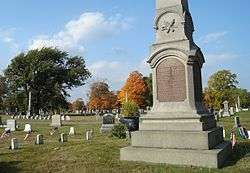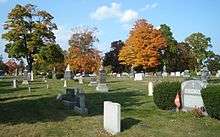Mount Wollaston Cemetery
Mount Wollaston Cemetery is a historic rural cemetery at 20 Sea Street in the Merrymount neighborhood of Quincy, Massachusetts. It was founded in 1855 and added to the National Register of Historic Places in 1984.
Mount Wollaston Cemetery | |
 | |
  | |
| Location | 20 Sea Street, Quincy, Massachusetts |
|---|---|
| Coordinates | 42°15′31″N 70°59′56″W |
| Built | 1855 |
| Architect | Briggs, Luther; Briggs, Daniel. |
| Architectural style | Gothic Revival |
| NRHP reference No. | 94000035 [1] |
| Added to NRHP | February 18, 1984 |
History
In 1854 when Hancock Cemetery in the center of the town had been filled to near capacity, a committee was formed at a town meeting to determine the site of a new burial ground. The committee chose a plot of land in the town farm, which had been donated by William Coddington and was located just west of the site of Quincy's founding spot, Mount Wollaston. Through the year the cemetery committee surveyed several cemeteries in the surrounding area for landscaping and architecture ideas, including Forest Hills Cemetery in Jamaica Plain and Mount Auburn Cemetery in Cambridge. After consulting with Superintendent Brims of Forest Hills, Luther Briggs of Dorchester was hired to design and build the cemetery. Briggs chose a gothic revival style for the architecture, and used the plot dimensions adopted by Mount Auburn as a template for Mount Wollaston. The first two plots were ceremoniously purchased on May 5, 1856 by Charles Francis Adams, Sr., prominent attorney and son of the late former President of the United States, John Quincy Adams.[2]
Monuments
An area known as the Veterans Section, located at the main Sea Street entrance to the cemetery, features several monuments honoring members of the military. The Civil War Monument, dedicated June 25, 1868, features a large granite monument surrounded by four period cannons.[3] Other memorials include a Spanish–American War Memorial, World War I, World War II, Korean War and Vietnam War Memorials and statuary monuments dedicated to the city's firemen and policemen.[4]
Notable burials

- Brooks Adams (1848-1897), historian
- Charles Francis Adams, Sr., (1807-1886) attorney, U.S. Congressman and ambassador to Great Britain
- Charles Francis Adams, Jr. (1835-1915), a Union commander in the American Civil War, railroad executive and historian
- Charles Francis Adams, III (1866-1954), yachtsman and Secretary of the Navy under President Herbert Hoover
John Quincy Adams II (1833-1894)-politician, soldier and lawyer
- Billy De Wolfe, (1907-1974) actor [5]
- Bob Gallagher, sportscaster[6]
- Ralph Talbot (1897-1918), first United States Marine Corps aviator to be awarded the Medal of Honor
- Harriet E. Wilson (1825-1900), considered the first female African-American novelist[7]
References
- "National Register Information System". National Register of Historic Places. National Park Service. April 15, 2008.
- Pattee, William S. (1878). A History of Old Braintree and Quincy: With a Sketch of Randolph and Holbrook. Green & Prescott. p. 148.
- "Mount Wollaston Cemetery, Sea Street, Civil War Monument". Quincy, Mass. Historical and Architectural Survey. Thomas Crane Public Library. Retrieved 2009-10-24.
- "Mount Wollaston, Sea Street, World War II Memorial". Quincy, Mass. Historical and Architectural Survey. Thomas Crane Public Library. Retrieved 2009-10-24.
- "Mount Wollaston Cemetery". findagrave.com. Retrieved 2009-10-24.
- "Robert L. (Bob) Gallagher, 48, Former 'Voice of Patriots'". The Boston Globe. July 4, 1977.
- Cengage, Gale (2006). "Our Nig". American History Through Literature. enotes.com. Archived from the original on December 6, 2008. Retrieved 2009-10-24.
| Wikimedia Commons has media related to Mount Wollaston Cemetery. |
